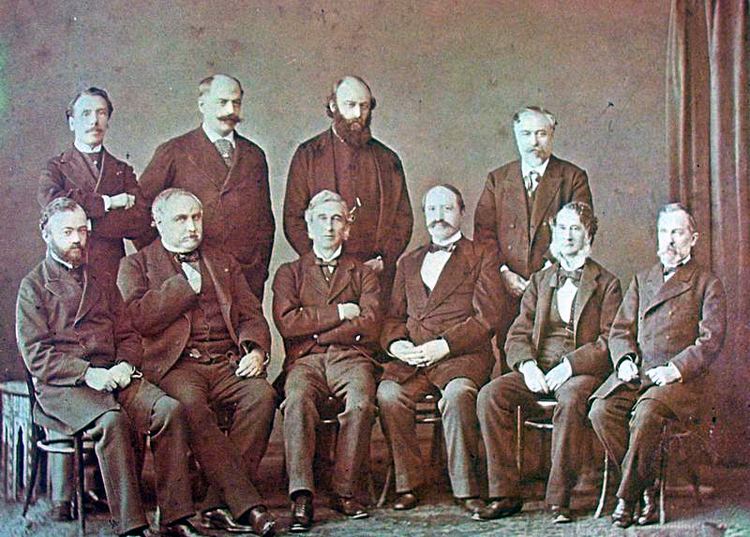Native name Tersane Konferansı Type Conference | ||
 | ||
Date December 23, 1876 – January 20, 1877 (1876-12-23 – 1877-01-20) Cause The Herzegovinian Uprising in 1875 and the Bulgarian April Uprising in 1876 | ||
The 1876–77 Constantinople Conference (Turkish: Tersane Konferansı "Shipyard Conference", after the venue Tersane Sarayı "Shipyard Palace") of the Great Powers (Britain, Russia, France, Germany, Austria-Hungary and Italy) was held in Constantinople (now Istanbul) from 23 December 1876 until 20 January 1877. Following the beginning of the Herzegovinian Uprising in 1875 and the April Uprising in April 1876, the Great Powers agreed on a project for political reforms both in Bosnia and in the Ottoman territories with a majority Bulgarian population.
Contents
Participants
The Great Powers were represented at the conference respectively by:
Of these, Lord Salisbury, Count de Chaudordy and Baron von Calice were Ambassadors Plenipotentiary to the conference, while Count Ignatyev, Sir Henry Elliot, Count de Bourgoing, Baron von Werther, Count Zichy and Count Corti were the resident Ambassadors of their countries in Constantinople.
The US Consul General in Constantinople, Eugene Schuyler also took an active part in drafting the conference decisions.
The Ottoman Empire was represented at the conference by:
Midhat Pasha, Saffet Pasha and Edhem Pasha.Midhat Pasha was the Grand Vizier (First Minister), and Saffet Pasha the Foreign Minister of the Ottoman Empire. Although the Ottoman representatives participated in the plenaries of the conference, they were not invited to the preceding working sessions at which the Great Powers negotiated their agreement.
Lord Salisbury and Count Ignatyev played a leading role in the process. Ignatyev was trying to dispel British misgivings about Russia’s assumed role of a protector of the Orthodox Slavs being but a disguise of its drive to take over the Black Sea Straits and Constantinople itself and thus – as Prime Minister Disraeli feared – potentially threaten the vital Mediterranean routes to British India. On his part, Salisbury saw the conference as a promising opportunity for mapping out a comprehensive deal with Russia over their conflicting territorial ambitions in Central Asia.
Bosnia
The conference envisaged the creation of an autonomous province including Bosnia and most of Herzegovina, while a southern part of the latter was to be ceded to the Principality of Montenegro.
Bulgaria
The Great Powers agreed on a substantial Bulgarian autonomy to take the form of two new Ottoman provinces (vilayets) established for the purpose: Eastern, with capital Tarnovo, and Western, with capital Sofia.
The conference determined that, as of the late 19th century, the Bulgarian ethnic territories within the Ottoman Empire extended to Tulcea and the Danube Delta in the northeast, Ohrid and Kastoria in the southwest, Kirklareli and Edirne in the southeast, and Leskovac and Niš in the northwest. These territories were to be incorporated into the two Bulgarian autonomous provinces as follows:
The Great Powers elaborated in detail the constitutional, legislative, executive, defense and law enforcement arrangements, cantonal administrative system, taxation, international supervision etc. for the proposed autonomous provinces.
Conclusion
The agreed decisions of the six Great Powers were formally handed over to the Ottoman Government on 23 December 1876, dismissing the opening Ottoman suggestions that the Conference's mission might have been obviated by a new Ottoman Constitution approved by Sultan Abdul Hamid II that same day. In the subsequent conference plenary sessions the Ottoman Empire submitted objections and alternative reform proposals that were rejected by the Great Powers, and attempts to bridge the gap did not succeed. Eventually, on 18 January 1877 Grand Vizier Midhat Pasha announced the definitive refusal of the Ottoman Empire to accept the conference decisions.
Legacy
The rejection by the Ottoman Government of the decisions of the Constantinople Conference triggered the 1877–1878 Russo-Turkish War, depriving at the same time the Ottoman Empire – in contrast to the preceding 1853–1856 Crimean War – from Western support.
Tsarigrad Peak in Imeon Range on Smith Island in the South Shetland Islands, Antarctica is named after the conference (‘Tsarigrad’ being the old Bulgarian name for Constantinople).
